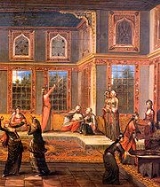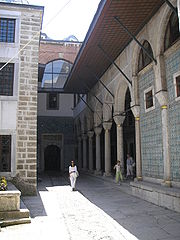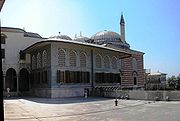
Imperial Harem
Encyclopedia

Ottoman Empire
The Ottoman EmpireIt was usually referred to as the "Ottoman Empire", the "Turkish Empire", the "Ottoman Caliphate" or more commonly "Turkey" by its contemporaries...
(1299-1923) was one of the most important elements of the Ottoman court
Ottoman court
Ottoman court or the culture that evolved around the court of the Ottoman Empire was known as the "Ottoman Way". To get a high position in the empire, one must be skilled in the Way. It included both knowing Persian, Arabic and Ottoman Turkish and how to behave in court, in front of the sultan, and...
. It was known in the West as "the Seraglio
Seraglio
A seraglio or serail is the sequestered living quarters used by wives and concubines in a Turkish household. The word comes from an Italian variant of Turkish saray, from Persian sarai , meaning palace, or the enclosed courts for the wives and concubines of the harem of a house or palace...
", an Italian
Italian language
Italian is a Romance language spoken mainly in Europe: Italy, Switzerland, San Marino, Vatican City, by minorities in Malta, Monaco, Croatia, Slovenia, France, Libya, Eritrea, and Somalia, and by immigrant communities in the Americas and Australia...
term.
Harem quarters
The Imperial Harem occupied one of the large sections of the private apartments of the sultan at the Topkapi Palace which encompassed more than 400 rooms. After 1853, an equally lavish harem quarter was occupied at the new imperial palace at DolmabahçeDolmabahçe Palace
Dolmabahçe Palace located in the Beşiktaş district of Istanbul, Turkey, on the European coastline of the Bosphorus strait, served as the main administrative center of the Ottoman Empire from 1856 to 1922, apart from a 22-year interval in which Yıldız Palace was used.- History :Dolmabahçe Palace...
.
Role of the Valide Sultan ("Queen Mother")
The mother of a new Sultan came to the harem with pomp and circumstance and assumed the title of Queen MotherQueen mother
Queen Mother is a title or position reserved for a widowed queen consort whose son or daughter from that marriage is the reigning monarch. The term has been used in English since at least 1577...
(Valide Sultan
Valide Sultan
Valide Sultan was the title held by the mother of a ruling Sultan in the Ottoman Empire. The Turkish pronunciation of the word Valide is . The title is sometimes translated as Queen Mother, although the position of Valide Sultan was quite different.The position was perhaps the most important...
) upon her son's ascension. She was paramount chief and ran the Harem and ruled over the members of the dynasty. The Valide Sultan
Valide Sultan
Valide Sultan was the title held by the mother of a ruling Sultan in the Ottoman Empire. The Turkish pronunciation of the word Valide is . The title is sometimes translated as Queen Mother, although the position of Valide Sultan was quite different.The position was perhaps the most important...
who influenced the political life of the Ottoman Empire
Ottoman Empire
The Ottoman EmpireIt was usually referred to as the "Ottoman Empire", the "Turkish Empire", the "Ottoman Caliphate" or more commonly "Turkey" by its contemporaries...
during various periods of history had the authority to regulate the relations between the sultan and his wives and children. The Valide Sultan was a majestic symbol of the Ottoman dynasty and wielded great power.
Role of the concubines

Ottoman Dynasty
The Ottoman Dynasty ruled the Ottoman Empire from 1299 to 1922, beginning with Osman I , though the dynasty was not proclaimed until Orhan Bey declared himself sultan...
and service to it, beautiful and intelligent slave girls were either captured in war (mainly Christian Europeans in the Balkans), recruited within the empire, or procured from neighbouring countries to become imperial concubines (Cariyes).
The concubines who were introduced into the Harem in their tender age were brought up in the disciplines of the Palace. They were promoted according to their capacities and became kalfas and ustas.
The concubine with whom the Sultan shared his bed became a member of the dynasty and rose in rank to attain the status of Gözde (the Lucky), Ikbal (the Favourite) or Kadın (the Wife). The highest position herself was the Queen Mother (Valide Sultan), the mother of the Sultan, who herself used to be a concubine of the Sultan’s father and rose to the supreme rank in the Harem. No concubine could leave or enter the premises of the Harem without the explicit permission of the Queen Mother. The power of the Queen Mother over concubines even extended to questions of life and death, with eunuchs directly reporting to her.
The concubines either lived in the halls beneath the apartments of the consorts
Queen consort
A queen consort is the wife of a reigning king. A queen consort usually shares her husband's rank and holds the feminine equivalent of the king's monarchical titles. Historically, queens consort do not share the king regnant's political and military powers. Most queens in history were queens consort...
, the Queen Mother and the Sultan, or in separate chambers.
The kadıns, who numbered four, formed the group who came next in rank to the Queen Mother. Right below the kadins in rank were the ikbals, whose number was unspecified. Last in the hierarchy were the gözdes. The favourite consort who was the mother of the crown prince, as well as the other kadıns, enjoyed a privileged position in the hierarchy of the harem.
Role of the eunuchs

Topkapi Palace
The Topkapı Palace is a large palace in Istanbul, Turkey, that was the primary residence of the Ottoman Sultans for approximately 400 years of their 624-year reign....
, at the court of the Ottoman sultans, the harem staff commonly included eunuch
Eunuch
A eunuch is a person born male most commonly castrated, typically early enough in his life for this change to have major hormonal consequences...
s. These were slaves, either captured in war (mainly Christian Europeans in the Balkans
Balkans
The Balkans is a geopolitical and cultural region of southeastern Europe...
) or recruited within the empire (especially from the Caucasus
Caucasus
The Caucasus, also Caucas or Caucasia , is a geopolitical region at the border of Europe and Asia, and situated between the Black and the Caspian sea...
and blacks from Sudan
Sudan
Sudan , officially the Republic of the Sudan , is a country in North Africa, sometimes considered part of the Middle East politically. It is bordered by Egypt to the north, the Red Sea to the northeast, Eritrea and Ethiopia to the east, South Sudan to the south, the Central African Republic to the...
) or even beyond (especially in Abyssinia
Ethiopia
Ethiopia , officially known as the Federal Democratic Republic of Ethiopia, is a country located in the Horn of Africa. It is the second-most populous nation in Africa, with over 82 million inhabitants, and the tenth-largest by area, occupying 1,100,000 km2...
). Black eunuchs usually were Sandali (i.e. their genitalia were entirely amputated), hence they were preferred for harem service, while White eunuchs usually kept part of their penis and/or testicles, so they were assigned to less 'intimate' duties, e.g. secretarial. They were often donated to the Sultan by his governors, in total about six- to eight hundred.
The castrated servicemen in the Muslim
Muslim
A Muslim, also spelled Moslem, is an adherent of Islam, a monotheistic, Abrahamic religion based on the Quran, which Muslims consider the verbatim word of God as revealed to prophet Muhammad. "Muslim" is the Arabic term for "submitter" .Muslims believe that God is one and incomparable...
and Turkish states in the Middle Ages
Middle Ages
The Middle Ages is a periodization of European history from the 5th century to the 15th century. The Middle Ages follows the fall of the Western Roman Empire in 476 and precedes the Early Modern Era. It is the middle period of a three-period division of Western history: Classic, Medieval and Modern...
were recruited to serve in the palace from the times of Sultan Mehmed I
Mehmed I
Mehmed I Çelebi was a Sultan of the Ottoman Empire from 1413 to 1421. He was one of the sons of Bayezid I and Valide Sultan Devlet Hatun Mehmed I Çelebi (Ottoman: چلبی محمد, Mehmed I or Mehmed Çelebi) (1382, Bursa – May 26, 1421, Edirne, Ottoman Empire) was a Sultan of the Ottoman Empire...
onwards. These eunuchs who were trained in the palace and were given the charge of guarding the harem rose in rank after serving in many positions. The harem eunuchs and the harem organisation were under the command of the Chief harem eunuch, who was also called the Master of the Girls (Kızlar Ağasi) or Chief Black Eunuch. They supervised the quarters where the female population of the palace lived. They had influence on the palace and later on the state administration in the 17th and 18th centuries as they had access to the sultan and the sultan's family and became very powerful. Eunuchs at the Ottoman court were preferably taken from Africa, especially Sudan.
The Chief Black Eunuch was sometimes considered second only to the Grand Vizier
Grand Vizier
Grand Vizier, in Turkish Vezir-i Azam or Sadr-ı Azam , deriving from the Arabic word vizier , was the greatest minister of the Sultan, with absolute power of attorney and, in principle, dismissable only by the Sultan himself...
(head of the imperial government, but often working in his own palace or even away, e.g., on military campaign) in the confidence of the Sultan, to whom he had and arranged access (including his bedchamber, the ne plus ultra for every harem lady), also being his confidential messenger. As commander of an imperial army corps, the halberd
Halberd
A halberd is a two-handed pole weapon that came to prominent use during the 14th and 15th centuries. Possibly the word halberd comes from the German words Halm , and Barte - in modern-day German, the weapon is called Hellebarde. The halberd consists of an axe blade topped with a spike mounted on...
iers (baltaci), he even held the supreme military dignity of three-tail pasha
Pasha
Pasha or pascha, formerly bashaw, was a high rank in the Ottoman Empire political system, typically granted to governors, generals and dignitaries. As an honorary title, Pasha, in one of its various ranks, is equivalent to the British title of Lord, and was also one of the highest titles in...
(general).
Meanwhile the Chief White Eunuch (Kapı Ağasi), was in charge of 300 to 900 white eunuchs as head of the 'Inner Service' (the palace bureaucracy, controlling all messages, petitions, and State documents addressed to the Sultan), head of the Palace School
Palace school
The Palace school was part of the House of Osman's system, designated to educate the Ottoman Empire's governing elite. It consisted of two distinct branches. The Madrasa for the Muslims, which educated the scholars and the state officials in accordance with Islamic tradition...
(school for pages training as white eunuchs), gatekeeper-in-chief, head of the infirmary, and master of ceremonies of the Seraglio, and was originally the only one allowed to speak to the Sultan in private. In 1591, Murad III
Murad III
Murad III was the Sultan of the Ottoman Empire from 1574 until his death.-Biography:...
transferred the powers of the white to the black eunuchs as there was too much embezzlement
Embezzlement
Embezzlement is the act of dishonestly appropriating or secreting assets by one or more individuals to whom such assets have been entrusted....
and various other nefarious crimes attributed to the white eunuchs, but later they regained some favour.
During the Sultanate of Women
Sultanate of Women
The Sultanate of Women was the near 130-year period during the 16th and 17th centuries when the women of the Imperial Harem of the Ottoman Empire exerted extraordinary political influence. Many of the Sultans during this time were minors and it was their mothers, leaders of the Harem, who...
(Kadınlar Sultanati), the eunuchs increased their political leverage by taking advantage of minor or mentally incompetent Sultans, causing political instability. The teenage Sultans were "guided" by regencies formed by the Queen Mother (Valide Sultan), the Grand Vizier and the Valide's other supporters- and the Chief Black Eunuch was the Queen Mother's and Chief Consorts' intimate and valued accomplice.
Golden Cage

Kafes
Kafes, literally "the cage", was the part of the Imperial Harem of the Ottoman Palace where possible successors to the throne were kept under a form of house-arrest and constant surveillance by the palace guards....
, which translates as "cage" from Ottoman Turkish. Here the princes had to live in seclusion until they were either executed so as not be a threat to the crown prince, or be released once they became sultans. This change had a very negative effect on quality and abilities of later Ottoman sultans.
Other sources
- İlhan Akşit. The Mystery of the Ottoman Harem. Akşit Kültür Turizm Yayınları. ISBN 975-7039-26-8

